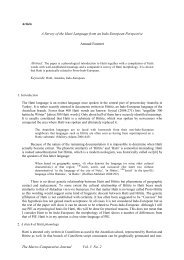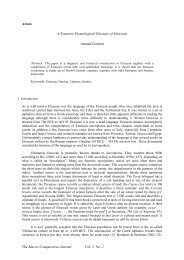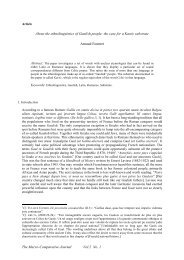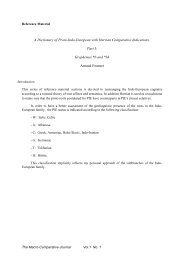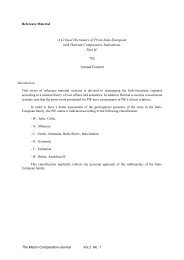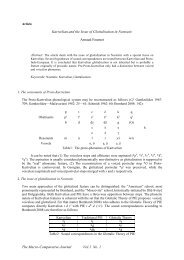The Kassite Language In a Comparative Perspective with
The Kassite Language In a Comparative Perspective with
The Kassite Language In a Comparative Perspective with
You also want an ePaper? Increase the reach of your titles
YUMPU automatically turns print PDFs into web optimized ePapers that Google loves.
<strong>The</strong> <strong>Kassite</strong> <strong>Language</strong><br />
− burna ‘protégé, servant’ = Bab. kidīnu ~ Hurrian burami ‘servant’ ~ Urartian (LÚ) bura ‘slave,<br />
servant’.<br />
− Dur(a) (n. 14) = Bab. d Nergal ‘god of the netherworld’ ~ Hurrian turi ‘inferior’ and enna<br />
turina which translates Hittite katteres siunes ‘infernal gods’ (Laroche 1980:273).<br />
− Tišpak ‘the god Tišpak’ ~ Hurrian Teššub ~ Urartian Teiššaba. Possibly a contraction<br />
*Teššub-ak > Tišpak.<br />
− yaš ‘land’ (n. 34) = Bab. ma-a-tum ‘land’ ~ Hurrian eše ‘earth’.<br />
As will appear below, there is some reason to doubt that all the words in Delitzsch (1884) are<br />
strict translations. It is more adequate to talk about semantic equivalents.<br />
4. About <strong>Kassite</strong> Person names<br />
Another source of <strong>Kassite</strong> data is the numerous Person names. Some of them have typical <strong>Kassite</strong><br />
morphemes and are therefore easy to identify <strong>with</strong> certainty. Following the observation that some<br />
<strong>Kassite</strong> words have very clear Hurro-Urartian cognates, one may wonder whether <strong>Kassite</strong> Person<br />
Names cannot be interpreted according the same syntagmatic structure as Hurrian Person Names:<br />
Verb + Noun, often a God name. <strong>The</strong> common vocabulary raises the issue of trying to understand or<br />
interpret potentially <strong>Kassite</strong> items using Hurrian words <strong>with</strong> similar shape. Purves in NPN (195)<br />
mentions the possibility that <strong>Kassite</strong> may be related to Elamite or Hattic but considers <strong>Kassite</strong> names<br />
to be easily distinguishable from other sources. <strong>The</strong> situation may not be that clear-cut as will<br />
gradually appear.<br />
<strong>The</strong> working hypothesis that will be developed in the paper is that Hurrian can shed light on<br />
<strong>Kassite</strong>. According to that scheme, a number of Person names can be interpreted as having a structure<br />
Verb + pronouns. <strong>The</strong> agglutinative morphology of <strong>Kassite</strong> can be interpreted according to the<br />
following pattern: Verb root - valency - Tense Marker - Objet - Subject, as in Hurrian. Valency is the<br />
same as in Hurrian: -a- for verbs of movement, -i- for transitive, -u- for intransitive verbs. Tense<br />
markers are either -Ø- for Present or -b- for Past, and possibly -l- for Optative. Pronouns are -di- for<br />
P1Sg (~ Hurrian -tta), -mba for P2Sg (~ Hurrian -mma), -aa for P3Sg <strong>In</strong>transitive, -(i)ya for P3Sg<br />
Transitive, -n(i)nu for P3Pl. Because this pattern and the pronominal forms are close to Hurrian it is<br />
not always clear whether a name is Hurrian or <strong>Kassite</strong>. Actually many names in NPN cannot be<br />
assigned to Hurrian or <strong>Kassite</strong> <strong>with</strong> as much certainty as is usually assumed. According to that scheme<br />
the <strong>Kassite</strong> names can be interpreted as follows:<br />
Noun Root Valency Tense Object Subject Meaning<br />
Al-ba-di-Sah al- -a- -b- di Sah Tsah brought me<br />
Ḫa-aš-te-ia haz- -Ø- -Ø- di a He hears me<br />
Ḫa-aš-te-e haz- -Ø- -Ø- di e She hears me<br />
Ḫa-ši-it-te haz- -i- -t < b- -i- di I heard him<br />
Ḫa-ši-lu-um-ti hazil- -i- -l- m di May I hear him<br />
Šim-di-Sah -Šipak šim -Ø- -Ø- di Sah Tsah, etc. gives me<br />
Structures <strong>with</strong> -di- P1Sg<br />
Noun Root Valency Tense Object Subject Meaning<br />
A-ba-am-ba ab- -a- -Ø- / mba<br />
You are the first<br />
one<br />
A-ri-pa-am-pa ar- -i- -b- -i- mba You gave him<br />
Ar-ru-um-pa ar- -u- -Ø- / mba You are given<br />
Ḫa-ša-am-pa haz- -a- -Ø- / mba You came to hear<br />
Ḫa-ši-pa-am-pa haz- -i- -b- -i- mba You heard him<br />
Ú-zi-im-pa-li-du udz- -i- -li- -mba- du<br />
Structures <strong>with</strong> -mba- P2Sg<br />
May they protect<br />
you<br />
<strong>The</strong> Macro-<strong>Comparative</strong> Journal Vol.2 No. 1 4



